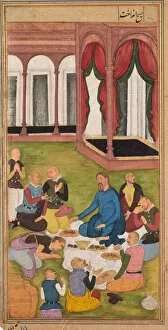Mughal Period Collection (#2)
The Mughal period was a time of great artistic and cultural flourishing in India, as seen through the exquisite artworks that have survived to this day
For sale as Licensed Images
Choose your image, Select your licence and Download the media
The Mughal period was a time of great artistic and cultural flourishing in India, as seen through the exquisite artworks that have survived to this day. One such artwork is "Jesus writes on the ground, " a mesmerizing painting from the Mirror of Holiness (Mir at al-quds) created between 1602-1604. This piece captures Jesus in a moment of contemplation, his fingers delicately tracing words on the earth. Another remarkable artwork from this era is "Four O Clock or The Marvel of Peru. " This stunning botanical illustration showcases the intricate beauty of nature during the Mughal period. Painted with meticulous detail, it highlights the vibrant colors and unique patterns found in flora. A procession scene with musicians, depicted in a copy of Padshanama, provides us with insight into the grandeur and opulence that characterized Mughal celebrations. The musicians play enchanting melodies while participants elegantly move forward, creating an atmosphere filled with joy and festivity. "The Flagellation" is another captivating piece from Father Jerome Xavier's Mirror of Holiness. It portrays Christ enduring his suffering before crucifixion—a poignant reminder of sacrifice and redemption within Christianity. In contrast to these religious themes, "The Flowering of Josephs Rod" presents a more mystical subject matter. It depicts Joseph's staff miraculously blooming with flowers—an allegory for divine intervention and blessings bestowed upon individuals. Father Jerome Xavier's Mir at al-quds also includes text pages that provide valuable insights into religious teachings during this period. These pages serve as windows into theological discussions and reflections on faith by scholars like Father Xavier himself. Religious scenes continue to dominate Mughal artistry; "The Adoration of Shepherds" beautifully captures their humble reverence towards baby Jesus—depicting both awe-inspiring divinity and human vulnerability simultaneously. Similarly, "The Adoration of Magi" showcases wise men offering precious gifts to the newborn King, symbolizing the universal recognition of Jesus' significance.


